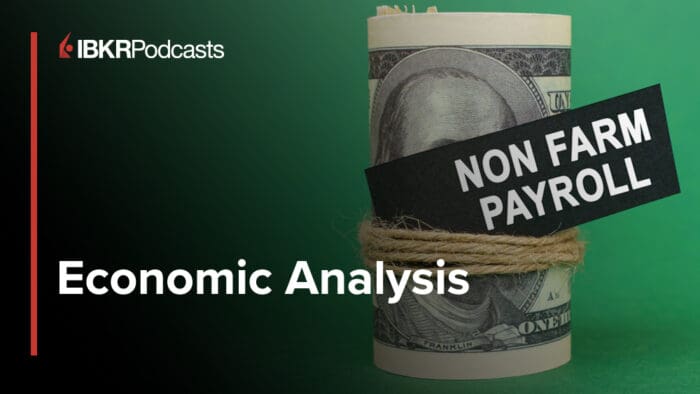In this week’s economic podcast from Interactive Brokers, Andrew Wilkinson hosts a discussion with Chief Strategist, Steve Sosnick and Senior Economist, Jose Torres. They analyze the June nonfarm payrolls report, noting both strengths like the addition of 206,000 jobs and weaknesses such as job losses in economically sensitive sectors. The conversation also explores the Federal Reserve’s potential actions, inflation trends, and consumer spending behavior amidst economic uncertainties.
Summary – IBKR Podcasts Ep. 172
The following is a summary of a live audio recording and may contain errors in spelling or grammar. Although IBKR has edited for clarity no material changes have been made.
Andrew Wilkinson
Welcome to this week’s economic podcast from Interactive Brokers. Joining me to discuss economics this week are Steve Sosnick, Interactive Brokers’ Chief Strategist, and Senior Economist, Jose Torres.
Steve Sosnick
Andrew, great to see you again.
Jose Torres
Hi Andrew, hi Steve, great to be here.
Andrew Wilkinson
Jose, let’s start with you. Can you give us an overview of the June nonfarm payrolls report, some of the strengths and weaknesses, perhaps?
Jose Torres
Sure. So, we added 206,000 jobs, slightly above expectations, calling for 195, 000. Strong number on balance. However, when we go under the hood, we see a lot of weakness, particularly amongst the non-cyclical areas. Government, Private Education, and Health Services actually added 75%. of the total month’s gains. Also, some of the economically sensitive sectors like professional business services, retail trade, and manufacturing actually lost jobs.
And I would say the number one weak point in the report was the unemployment rate ticking up to 4.1%. It was the third consecutive monthly increase.
One figure that I’ve been watching throughout my career has been the unemployment rates cycle trough. So historically, whenever you go 50 basis points above the unemployment rate’s trough, this cycle, 3.4% , 50 basis points above that has always landed you in an economic downturn. Of course, this time could be different, but right now we’re 70 basis points above that rate.
And then we did see a sharp decline in temp help, and that also indicates reduced labor demand. Also on the stronger side, we saw wages grow 0. 3 percent month over month, 3. 9 percent year over year. Still pretty strong. We still have scarce workers out there there’s labor scarcity, employers are having difficulty matching the skills that they require with the folks that are applying for those jobs, overall, but I would say yields went down, stocks went up,
Steve Sosnick
My question for you, Jose, is actually immediately, like, started looking up the SOM rule as a result of that. I was always of the belief that it was just 50 basis points, but the rule as it’s written is actually if the three month moving average of unemployment rate goes up more than 50 basis points and we’re stubbornly at 50 basis points, are you more of a subscriber to the SOM rule with the moving averages, or do you prefer , the gross, 70 basis points that you mentioned?
Jose Torres
I like both, Steve. But mind you, my level is 50 basis points. It’s just so happens that this cycle we’re at 70.
I do like both, but I don’t have a strong preference on either side, Steve, I think the most important point from a historical perspective is that once joblessness starts to increase, that has an accelerating feature to it, right?
So once folks start to lose their jobs, then they’re not spending as much. Folks that would have gained that revenue now, they’re not spending at their suppliers as much, and then it sort of spreads, right? So I think that’s really the fundamental underpinning with, with those rules.
Andrew Wilkinson
So, Steve, give us your perspective on the implications of the June payrolls report for the Fed.
Do you think this increases the likelihood of multiple interest rate cuts by the end of the year?
Steve Sosnick
I don’t think they’re going to do anything in July. If they’re data dependent, the data is certainly pointing in the wrong direction, or I guess the right direction if you’re favoring rate cuts.
But the Fed doesn’t like to surprise the markets and the market is not anticipating a surprise.
Interestingly, the expectations for September sort of remained stubbornly in that 70 to 85 percent range, , sort of centered in the high 70s or around 80 percent. It hasn’t actually changed all that much.
But I really do believe that the tone coming out of the meeting and when we learn what the minutes are several weeks later, we’ll find that this has been a very consequential meeting because I think it is pretty clear that the economy is starting to slow down.
The question about the slowness becomes whether this is persistent or whether the Fed is still watching weight and can things metastasize in a negative way without Fed action? That to me is a bigger risk right now.
Andrew Wilkinson
So, the other side of the coin here, Jose, is inflation. Consumer price index coming out later this week. we’ve also got the producer price index. This is a really critical point for the Fed. Is inflation behaving the way you’d expect? Is it going to allow them to cut interest rates soon?
Jose Torres
June is a report we’ll get later this week. Those reports are going to be really cool. They’re helped by declining energy and goods prices.
But from January to April, you actually got four unfavorable inflation reports consecutively, right? Does two outweigh four, right?
Also you have to consider the fact that base effects are becoming unfavorable. Remember last year, second half, we saw a lot of disinflation. So as we move into the second half of this year, those year over year comps become more difficult. In fact, in the Fed’s dots, they have the core PCE finishing the year at around 2.8%.
We have some bumps on the road, right? We can easily finish 2.9%, 3%. Even 3. 1, right? so I think that May and June are already in the bag, but Andrew, the most important ones are going to be July and August .
They’re not tracking that great on the former month because oil prices are at a two month high. And then also, and I’ll, , toss this to Steve, if he wants, September is really close to that presidential election, right?
Does the Fed maybe err on the side of caution to maybe not appear too political?
Steve Sosnick
That’s gotta be a consideration. That’s kind of why, yet again, September Shapes Up is another careful what you wish for type of meeting.
Remember at the beginning of the year, and we’ve discussed this at length, was that, you can’t have a decent economy and the six or seven rate cuts that the market was predicting.
Now, the market voted, I think, as we all did, on the side of a stronger economy We dealt with that and we’re able to avoid the idea of rate cuts at all.
but to me November does strike me as a bit more palatable because the Fed meeting is actually the day after Election Day. The question is can we hold out for another six weeks?
Is the economy decelerating? The Atlanta Fed GDP now is somewhere mired in the low to mid one range. That’s not a recessionary economy, but it’s a slowing economy. The question really becomes what are the balance of risks at this point?
And political risk is certainly one of them. And probably the avoidance of it, is certainly, likely to be a consideration for the Fed. I think your point is a very good one.
If it’s a, if it’s a 50, 50 call, maybe they don’t move because they just don’t want to be perceived as putting their thumb on the scale right now.
Andrew Wilkinson
Jose, was there anything in the employment report last week that offers meaningful clues about the health of the U. S. consumer at this stage?
Jose Torres
Absolutely, Andrew. Consumer spending has been quite erratic. In fact, this cycle, call it since 2022, off the top of my head, leisure and hospitality employment was a leading category, right? Amongst the cyclicals, it always was one of the top gainers. Now, last month, however, you saw job gains pretty much screech to a halt.
I think we added, uh, roughly 7, 000 jobs only in leisure and hospitality, right? And that’s the discretionary sector, right? Let’s go out to eat, let’s go fly somewhere, let’s go watch a movie, etc. So that’s really lining up with what we’re seeing in other data points like ISM Services, Retail Sales, Continuing Unemployment Claims, which are at a 32 month high.
Initial Unemployment Claims, however, are still pretty well anchored close to that 230 level, not reasons for concern right here right now, but that does point to Sharp deceleration.
With continuing claims, 32 month high. What that means is that folks, if they get laid off or if they quit, generally speaking, they’re not able to find a job by tomorrow or in two days.
It’s taking them a week or two weeks to replace those jobs. Initial unemployment claims telling us that corporates are still hoarding labor.
They still want to keep their folks in case the Fed cuts and we start expanding meaningfully, not be under a staff shortage.
So overall, we’re seeing Labor demand become reduced because revenues are beginning to come under pressure.
Final point here in ISM services, we saw an abrupt weakening in April. Then in May, we leaped back into contraction territory, only to submerge back deep into contraction territory in June, right? So consumer spending is becoming erratic like a light switch. On and off, I’m going to spend a lot this month, but next month let me hold off and then resume the following.
As that erraticness begins to increase, I’m afraid that , economic turbulence is right around the corner.
Steve Sosnick
One of the things, Jose, is that we’re about to enter earnings season at the end of this week and then into the following weeks.
I think it’ll be fascinating to see whether consumer goods companies can continue to pass along price increases as they were crowing about a few quarters ago.
Then they kind of stopped talking about it. Now we’re starting to hear more emphasis on value, meals, that kind of thing.
I think that’s, A big tell, and I think it does speak to sort of the bifurcation of the labor market, where you have high income consumers. And by the way, those are the people who tend to power the stock market because they have excess funds to invest, continuing to put money into the markets.
Whereas the consumers who are a bit more stretched, have to retrench a bit. And that I do think is going to be a very interesting dynamic going forward.
Andrew Wilkinson
Well, Steve, Chairman Powell has his twice annual chance to speak to Congress and deliver a message over the summer.
Steve Sosnick
It’ll be interesting to hear what Powell is likely to say. . The more important thing with Powell isn’t so much usually what he says, it’s, what the market chooses to hear.
and I think what the market chooses to hear from him is usually the more rosyside of the message, that’s why I kind of call him Goldilocks in a suit more, often than not.
He’s not an economist by trade, but he certainly learned the two handed method. On one hand this, on the other hand that.
And when he presents what I think he believes Sincerely is a balanced view, the market tends to hear the glass half full side of the equation.
And in some cases it’s even that we’re not cutting rates, but, we might, if things go bad, and the market hears that as, wait, so I have a chance?
So this is, I think, where we’re going to get out of it. The Senate, to me, tends to be a bit more of a useful listening exercise because the questions there are more broad based, just the nature of the Senate, as opposed to the House, where I think you have a bunch more specific agenda items, which may or may not be relevant to someone in a specific district, but less relevant to the nation as a whole.
And of course there will always be your share of gotcha type of moments. Somebody wants to get the soundbite on TV.
But, ultimately I just want to see if he is cognizant of the idea that we might be slowing down without being alarmist.
And that’s going to be what I’m listening for.
Andrew Wilkinson
Brilliant. Steve Sosnick, Thank you very much for joining me. Jose Torres down in West Palm Beach, thank you for joining me. And to the audience, please remember to rate our episodes and look out for more at IBKR Podcasts. Thanks guys.
Join The Conversation
If you have a general question, it may already be covered in our FAQs. If you have an account-specific question or concern, please reach out to Client Services.
Leave a Reply
Disclosure: Interactive Brokers
The analysis in this material is provided for information only and is not and should not be construed as an offer to sell or the solicitation of an offer to buy any security. To the extent that this material discusses general market activity, industry or sector trends or other broad-based economic or political conditions, it should not be construed as research or investment advice. To the extent that it includes references to specific securities, commodities, currencies, or other instruments, those references do not constitute a recommendation by IBKR to buy, sell or hold such investments. This material does not and is not intended to take into account the particular financial conditions, investment objectives or requirements of individual customers. Before acting on this material, you should consider whether it is suitable for your particular circumstances and, as necessary, seek professional advice.
The views and opinions expressed herein are those of the author and do not necessarily reflect the views of Interactive Brokers, its affiliates, or its employees.



















Thanks for a well-balanced program.
We hope you continue to enjoy IBKR Podcasts!